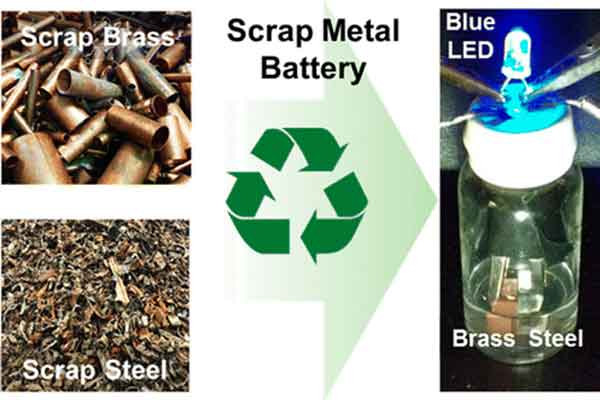With residential solar energy ramping up, consumers are looking for ways to store extra energy without breaking the bank. To help solve this problem, a team of scientists has come up with a novel possibility: do-it-yourself, scrap-metal batteries. They report their method in the journal ACS Energy Letters.
One of the most obvious choices these days for back-up energy storage is the lithium-ion battery. This option, however, requires a complex, global supply chain and high-end manufacturing facilities. But making batteries hasn’t always been so hi-tech.
The world’s first speculated batteries originated during the first century B.C. with a terracotta pot, a copper sheet and an iron rod, according to Cary L. Pint and colleagues. Going back to this simple predecessor known as the “Baghdad battery,” the scientists decided to pursue a similarly basic device using scrap steel and brass, which respectively make up the most and the third-most abundant kinds of scrap metal waste in the U.S.

First full cell battery device that is developed entirely from scrap metals of brass and steel—two of the most commonly used and discarded metals. A room-temperature chemical process is developed to convert brass and steel into functional electrodes for rechargeable energy storage that transforms these multicomponent alloys into redox-active iron oxide and copper oxide materials. The resulting steel–brass battery exhibits cell voltages up to 1.8 V, energy density up to 20 Wh/kg, power density up to 20 kW/kg, and stable cycling over 5000 cycles in alkaline electrolytes. Further, the versatility of this technique enables processing of steel and brass materials of different shapes, sizes, and purity, such as screws and shavings, to produce functional battery components. The simplicity of this approach, building from chemicals commonly available in a household, enables a simple pathway to the local recovery, processing, and assembly of storage systems based on materials that would otherwise be discarded. Credit: American Chemical Society
Pint and his team developed a simple process that could be carried out at home to prepare steel and brass scraps of varying sizes and shapes, including shavings and screws, to turn them into effective electrodes for batteries.
When the electrodes were combined with aqueous potassium hydroxide as the electrolyte, they yielded a battery with a voltage of up to 1.8 volts and an energy density up to 20 watt hours per kilogram, which approaches that of traditional lead-acid and nickel-iron batteries. Testing showed the st
Reference(s):
Publication: Nitin Muralidharan, Andrew S. Westover, Haotian Sun, Nicholas Galioto, Rachel E. Carter, Adam P. Cohn, Landon Oakes, Cary L. Pint. From the Junkyard to the Power Grid: Ambient Processing of Scrap Metals into Nanostructured Electrodes for Ultrafast Rechargeable Batteries. ACS Energy Letters, 2016
Research story: American Chemical Society | November 02, 2016 (source)













Comments